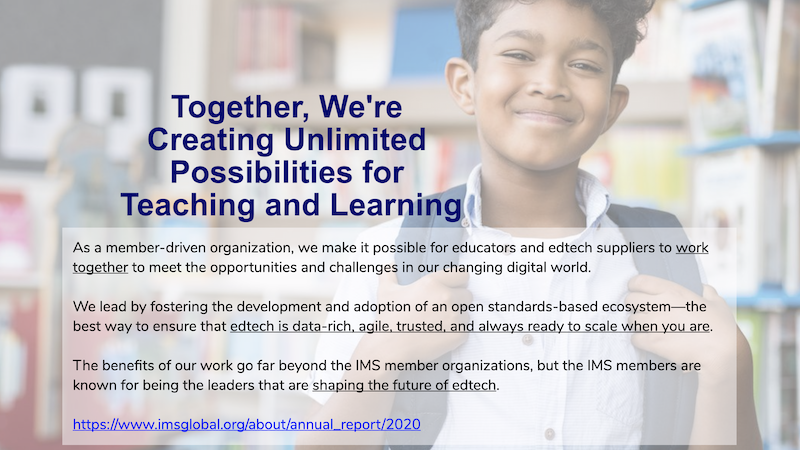 Rob Abel, Ed.D. | October 2021
Rob Abel, Ed.D. | October 2021
"Clarity" —John Mayer
Some Challenges to Consider as We Continue to Grow a Healthy EdTech Ecosystem
Having completed a very successful Learning Impact 2021 virtual conference, and looking forward to our upcoming in-person meetings, including our K-12 Leadership Retreat (in Denver, 10-11 November) and our annual Digital Credentials Summit (in Atlanta, 28 February through 2 March 2022), I’ve never been more hopeful and optimistic about the IMS community cause of enabling a vibrant, innovative, open edtech ecosystem.
However, I’ve also never been more concerned about a confluence of factors I hear about from the IMS members that may slow our progress.
First, let me cover some of the many things to consider on the optimism side of the equation.
We’ve reached new heights in so many ways. Our community and the market highlighted the power of open standards-based ecosystems during the pandemic. Both the number of products going through IMS certification and individuals participating in IMS exceeded 6,000. IMS standards are used in the most widely used edtech products on the planet, positively impacting nearly all students and teachers in the USA and growing in many other parts of the world.
The IMS work agenda has never been more vibrant, relevant, and horizon-expanding (in terms of supporting/encouraging new educational models). IMS provides a new generation of tools to help edtech participants troubleshoot and converge the use of open standards in practice. Probably most importantly, everything we have achieved is based on a rock-solid technical process and financial foundation.
On the not-so-optimistic side of the equation, there are three factors that I am hearing from IMSmembers as potential sources of drag. First, there has been an impressive number of mergers/acquisitions/roll-ups/IPOs among edtech suppliers. While these are pretty “normal” in a growing market, they also can bring much uncertainty. Second, the “great resignation” and general post-pandemic uncertainty mean more attention on just keeping the lights on. Third, over the last several years, there has been growing confusion caused by well-meaning but not exceptionally expert organizations responding to funded initiatives—leading to less clarity and transparency when it comes to adherence to open standards. We know from many examples that when organizations are funded to advocate or implement interoperability, it rarely results in a solution that helps maintain or sustain open standards.
Again on the positive side of things, it is wonderful to see so much leadership in K-12 evolving to more personalized and equitable education. There is renewed interest and focus in higher education on enabling digital transformation to meet the many challenges going forward. It is an honor and privilege to work among so many leaders who are trying to improve education and willing to put in the time and effort to work together to lift up themselves and others. Might I suggest that we take a moment here to remember that the future we seek is dependent on achieving and maintaining a healthy edtech ecosystem based on open standards? And please remember that the impact we seek from open standards should be readily apparent: better user experiences, greater choice of products, lower cost integrations, and faster integrations. I am confidend the IMS community will navigate the challenges mentioned above and many more in the coming months and years, just as we have from the beginning.
That said, as someone who has put decades of my life into this mission—and fully acknowledging all our progress—I believe that now is a time when we will need to collaborate even more closely to ensure clarity and transparency in achieving open standards-based interoperability in edtech.


 October 2021 | You Need Data to Know How Much It Helps Your District
October 2021 | You Need Data to Know How Much It Helps Your District
